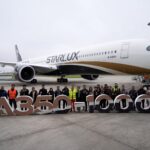It took a while for us all to get used to the full body scanners you often have to go through at airports to make sure you aren’t carrying anything you shouldn’t be onto the plane.
Now, you may have to walk through an entirely different type of automatic booth before you are allowed to board your aircraft.
Hong Kong was among the first countries, after China, to have to deal with the new coronavirus. So, it makes sense that Hong Kong would be at the forefront of looking ahead to the “new normal” of travel amid Covid-19.
In a world-first, the city’s airport is currently trialling full body disinfectant booths for its staff, with speculation rife that the process could be applied to passengers in Hong Kong and beyond if the trial is deemed to be effective.
 First, those passing through the booth have their temperature taken before they enter for the 40-second procedure. The inside of the disinfection chamber contains an antimicrobial coating to kill viruses and bacteria by using light and nano needles, which are thinner than a human hair.
First, those passing through the booth have their temperature taken before they enter for the 40-second procedure. The inside of the disinfection chamber contains an antimicrobial coating to kill viruses and bacteria by using light and nano needles, which are thinner than a human hair.
The occupant is also given a spritz of anti-bacterial mist before they leave the chamber. The chamber itself is pressurized to keep the external and internal air separate.
At the moment, the chamber is only for airport staff whose duties include public health and quarantine at the airport for arriving passengers. However, it could be that disinfectant chambers such as this become the norm for air travel as airlines, authorities and travellers try to work through what travel will look like in the future.
 The CleanTech booth is all part of stepped up high-tech cleaning efforts at Hong Kong International Airport, which is also deploying cleaning robots to disinfect public areas and passenger facilities.
The CleanTech booth is all part of stepped up high-tech cleaning efforts at Hong Kong International Airport, which is also deploying cleaning robots to disinfect public areas and passenger facilities.
The intelligent sterilization robots are equipped with ultra violet light and air sterilizers, and are busy round-the-clock in key areas and public toilets. The robots are capable of sterilizing up to 99.99% of bacteria in their path.
Meanwhile, the airport is also applying an antimicrobial coating at all passenger facilities to kill bacteria and viruses on often-touched surfaces such as handles, check-in kiosks, toilets, seats, baggage trolleys and elevator buttons.
All of these measures will be in place for a month. After the trial, the Hong Kong Airport Authority will decide what works best and whether the new cleaning regime will become a more permanent virus control strategy.
Steven Yiu, Deputy Director, Service Delivery of the AA, said: “Although air traffic has been impacted by the pandemic, the AA spares no effort in ensuring that the airport is a safe environment for all users.”









